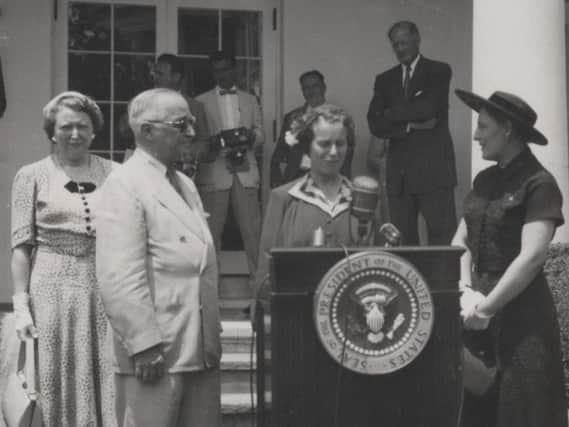Dame Caroline Haslett: Suffragette, engineer and an inspiration to women


In this 100th anniversary year of women winning the right to vote, we in Crawley should probably remember above all, the part played by our most acclaimed women’s equality campaigner. Caroline Haslett was born in Three Bridges on August 17 1895 and the 1901 census page shows her family as the second entry in New Road. In 1913, she became a Suffragette. Her sister, Rosalind Messenger, who was also her biographer, recorded how this incurred the displeasure of many, including her railway engineer father who objected to her having anything to do with “these women” and supported his protest with quotations from the Bible.But Caroline was so convinced of the justice of the Suffragette movement that her father’s words fell on deaf ears. In later years she never claimed to have played a part of great significance, but one story she enjoyed telling, perhaps being a little coy about her part in it, concerned herself as a young woman in early 1914, nervously chalking a slogan on the pavement outside the House of Commons – in language that she would not have been allowed to use at home – in the hope of being arrested.She was humiliated by a policeman, who told her: “You’re too young to go to prison. Be a good girl and get along home!”A few years on at a dinner with heroines of the struggle, Caroline was delighted to find herself sitting next to the renowned Mrs Emmeline Pankhurst. On hearing that Caroline hoped soon to become a fully qualified engineer, Mrs Pankhurst said to her: “But surely that’s a very unsuitable occupation for a lady, isn’t it?” Caroline, taken aback at the realisation of the chasm that still existed for women seeking professional careers, put Mrs Pankhurst in her place by telling her that doing a job in the right way was more important than whether it was done by a man or a woman.Caroline Haslett went on to have an illustrious career in electrical engineering, blazing a trail for the role of women in the workplace and electrical safety in the home.She chaired more top-level government and international conferences, committees and professional women’s institutions, engineering scholarships and fellowships than you could shake a conducting rod at.She became Dame Commander of the Order of the British Empire in 1947 at the same time as being appointed to Crawley New Town Development Corporation, overseeing the infrastructure planning of where we live today. Posthumously, a road (Haslett Avenue) was named after her and more recently a Crawley Arts Council blue plaque was fixed to the wall of Three Bridges electricity sub-station.You can read her biography – The Doors of Opportunity by Rosalind Messenger – in Crawley Library’s reference section.Three Bridges Forum is marking women’s suffrage centenary year by planning and seeking support for a prominent community arts project celebrating the life and works of Crawley’s local heroine Caroline Haslett.Caroline Haslett – at a glance- During the First World War, Caroline joined the Cochran Boiler Company where she acquired a basic engineering training.- In 1918, she answered an advert looking for a “lady with some experience in engineering works as organising secretary for a women’s engineering society.’ This was the Women’s Engineering Society (WES).- She became first secretary of the WES in 1919 and was president in 1941. - She was joint-founder of the Electrical Association for Women, becoming its first director in 1924.- Caroline became more well known to the wider public after the WES organised a special conference at Wembley in 1925. It was opened by the then Duchess of York (later Queen Elizabeth the Queen Mother).- She became chairman of the Council of Scientific Management in the Home and presented papers on home management in various countries.- Her work took her all over the world and she undertook missions for the British and United States governments during the Second World War.- Caroline was awarded a CBE in 1932 and a DBE in 1947.- She was a Justice of the Peace for the County of London (now known as Greater London).- She became president of the British Federation of Business and Professional Women and president of the International Federation in 1950.- When the new £5 was being designed, Dawn Bonfield MBE, of the Women’s Engineering Society, suggested Caroline’s image be used.- As well as Haslett Avenue, a primary school in Milton Keynes carries her name.- Caroline died in Suffolk in 1957 at the home of her sister. She was 61.Sources: Women’s Engineering Society and the IET Institution of Engineering and Technology